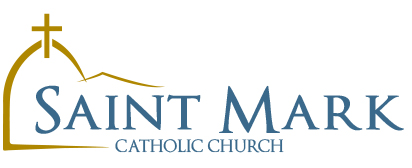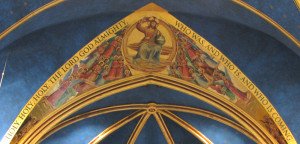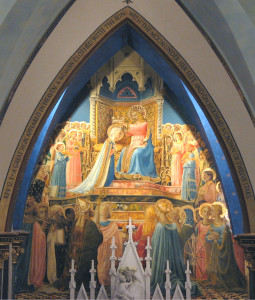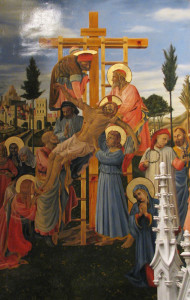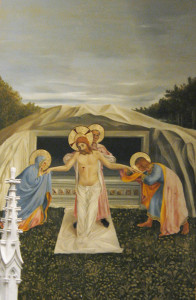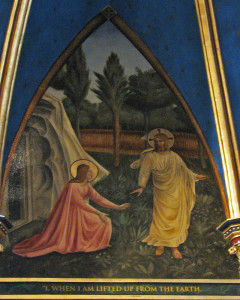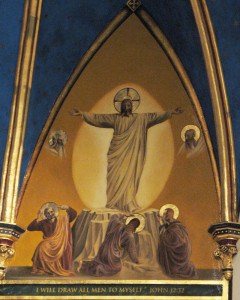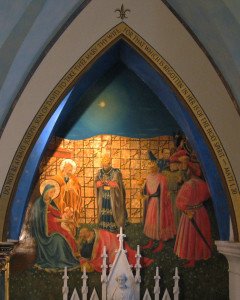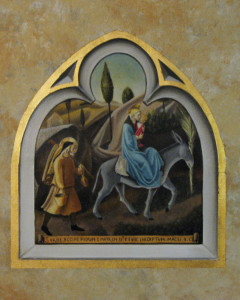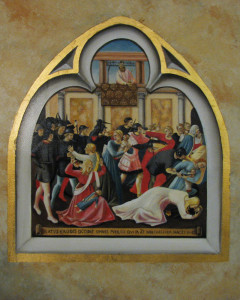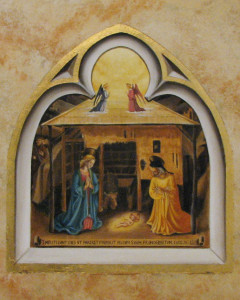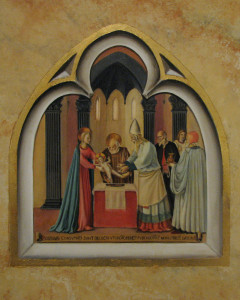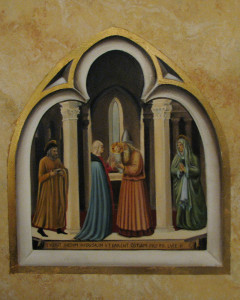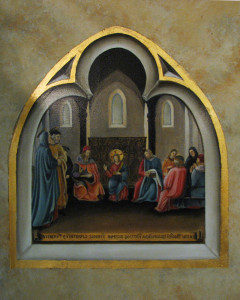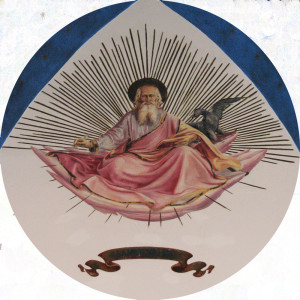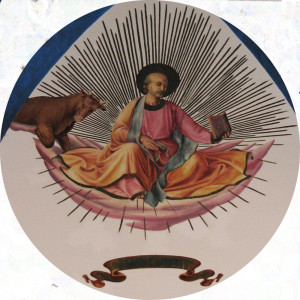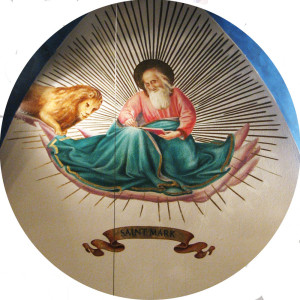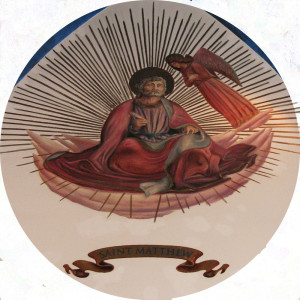Reproduced Paintings
Christ in Glory (Christ the Judge)
Depicted high above the main altar, the original was painted in Orvieto from 1444-1445, in the chapel of San Brizio for the dome of the sacristy. During the process, one of Fra Angelico’s assistants, Giovanni d’Antonio, fell from the scaffolding and was killed. Thus Fra Angelico could not bear to finish the work himself, which led to another artist, Luca Signorelli, doing so fifty years later. This scene is of the Last Judgment, with Jesus being served in heaven by the angels. On His right are the saints, and on His left are the damned in the fires of hell.
Coronation of the Virgin
This was the second piece reproduced at St. Mark, and is the beautiful backdrop for the Shrine of Our Lady. The original altarpiece was produced in the early 1430s for San Domenico in Fiesole. It was transported to Paris by Napoleon in 1812 and is now displayed in the Louvre, Paris. It shows Christ the King as he crowns the Virgin Mary Queen of Heaven and Earth. Following a tradition of Fra Angelico’s era, certain individuals from our parish, living and deceased were incorporated into this reproduction. A few faces in the crowd of saints in attendance were changed to represent people from Africa and Asia, who we are blessed to have in the St. Mark neighborhood. (84″ x 83″ – tempera and gold on panel)
The Deposition
This altarpiece was executed in the early 1440s for the Strozzi chapel, Santa Trinita, Florence. The original is now displayed in the Museo di San Marco in Florence. Jesus has died and is being taken down from the cross. We see that His Mother (in the blue gown), St. Mary Magdalene (in the red gown) and St. John, the beloved disciple (in the red robe with hands reaching to take the corpus) are the only disciples, as the Bible tells us, who remained with Our Lord to the end. All four gospels describe how when it was evening and there was darkness over the whole land, Jesus uttered a loud cry and breathed His last. Michelozzo, an architect and close acquaintance to Fra Angelico, may be represented in the figure with the dark headdress under Christ’s right arm. (69″ x 73″ – tempera and gold on panel)
The Entombment
Depicted on the lower half of the sanctuary wall, to the right of the crucifix, Christ’s body is being laid in the tomb. The original panel with the painting is on display in Munich, Germany. This panel is believed to be the center piece of the predella in the Coronation of the Virgin altar piece which was done in the early 1430s. Long time parishioner, now deceased, Deacon Charles Tuerk, is represented in this reproduction.
The Resurrection – Noli me tangere: Do not touch me
In the upper left half of the sanctuary wall, Christ is depicted as He appears in His glorified body to St. Mary Magdalene who has been weeping at His empty tomb. The title is Latin for “Touch me not, for I am not yet ascended to My Father.” It was originally painted in Cell (bedroom) 1 at the San Marco monastery in Florence between 1440 and 1441. The resurrected Jesus first appears to Mary Magdalene who had become a disciple after having led a very sinful life. (65″ x 49″ – fresco)
The Transfiguration
On the upper right half of the sanctuary wall, Jesus appears with the Old Testament prophets Moses and Elijah to the apostles Peter, James, and John. Jesus took the disciples Peter, James and John with him and went up a high mountain. As He prayed, “He was transfigured before them, and His face shone like the sun, and His garments became white as light.” Christ provided the apostles with a glimpse of the Resurrection to give them strength as He went through His Passion and death. A voice came from the cloud saying, “This is My Beloved Son, in Whom I am well pleased. Listen to him.” (Matthew 17: 5-6) Our Lord appeared in a transfigured state with His clothes and countenance a dazzling white to give the apostles a foretaste of heaven and the courage to bear the passion and death of the cross that was to come. Written below the mural are the words: “When I am lifted up, I will draw all men to myself.” (John 12:32) The original was painted between 1440-1441 in Cell 6 of the monastery of San Marco, Florence. (71″ x 60″ – fresco)
Adoration of the Magi
Reproduced behind St. Joseph’s side altar, this piece depicts the three kings coming to adore the Christ Child seen on His Mother’s knee, with St. Joseph standing next to them. After following the star in the East, three wise men found the Child with His Mother in Bethlehem and fell down and worshipped Him. The original work is part of a series of four reliquaries from the convent, Santa Maria Novella, probably executed in the late 1420s. They are now on display in the Museo di San Marco, Florence. Former pastor, Father Fitzgerald, and Father John Therese, CSJ from the Brothers of St. John who served the Newman Center, are depicted. Father Nicholas, Associate Pastor from Kitui, Kenya (2003-2005) is pictured as one of the Magi. (33″ x 20″ – tempera and gold on panel)
The Law of Love
Scenes from the Life of Christ (tempera and gold on panels, each approx. 15″ x 15″) The Nativity, The Circumcision, The Presentation in the Temple, The Flight into Egypt, The Massacre of the Holy Innocents, and The Finding of the Child Jesus in the Temple.
Flight into Egypt
Holy Innocents
Nativity
Circumcision
Presentation
Finding in the Temple
These scenes were chosen to be reproduced around St. Joseph’s side altar as they were times in Our Lord’s life when His adoptive father was present. The original panels were part of thirty-five scenes, divided into four panels, designed to decorate a silver chest for the Church of Santissima Annunziata in Florence. They were painted in the 1450s and are now on display in the Museo di San Marco. The title “Lex Amoris” refers to a doctrine of St. Thomas Aquinas that is elaborated in these paintings by allegory and inscription: Christ did not come to destroy the old laws of the patriarchs, but to renew and complete them with a new law of love. The Silver Treasury panels were destined to serve a large public as a kind of illustrated Bible. In 1450, on the eve of the invention of movable type, relatively few people possessed their own Bibles.
The Evangelists
St. John
St. Matthew
St. Mark
St. Luke
Above the four main arches, above and to the sides of the altar, are reproduced paintings of the gospel writers with Matthew and our patron saint, Mark to the left (west) and Luke and John to the right. The originals painted in the 1440s or 1450s are found on the ceiling of the Chapel of Pope Nicholas V at the Vatican. Symbols of each evangelist are included. St. Matthew whose gospel emphasizes Jesus as the fulfillment of God’s promise to the Jews is shown with an ox that represents the priestly character of our Lord and His sacrifice for our redemption. St. Mark’s gospel begins with John the Baptist quoting Isaiah and the voice of one crying out in the desert. That voice has been compared to the roar of a lion. St. Luke is shown with the angel as his gospels most vividly record the stories of God’s messages to Mary, to Joseph and others through an angel often seen as a young man. While John was the youngest apostle, he alone was not martyred and lived to an old age. He is represented as an old man with the eagle to represent the soaring wisdom he displayed in the visionary gospel of Revelations.
